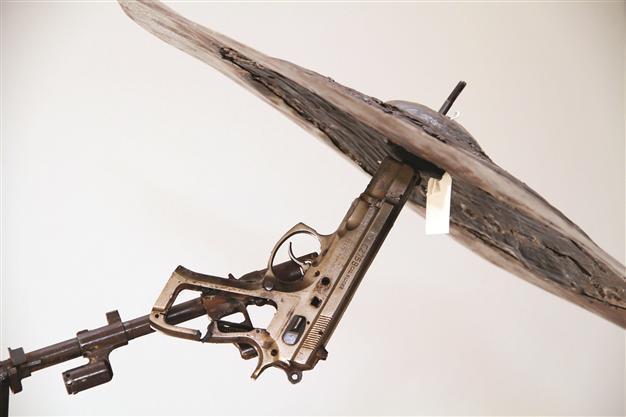Imperfections of life make it lovable
ISTANBUL - Hürriyet Daily News

In Pedro Reyes’ project titled ‘Imagine’ from Adhocracy, the guns were crushed by a steamroller and melted down in a foundry. Reyes transforms confiscated guns from Mexico into a fully-functional orchestra of musical instruments, including a flute, guitar, and drum kit.
When writer Joseph Campbell tried to describe Thomas Mann’s story of Tonio Kröger (a novella Mann published in 1903), he said, “The only way you can describe a human being truly is by describing his imperfections. The perfect human being is uninteresting,” continuing that, “It is the imperfections of life that are lovable. And when someone sends a dart of the true word, it hurts. But it goes with love.” This is what Mann called “erotic irony,” the love for that which you kill with your cruel, analytical word.
The first Istanbul Design Biennial can be perceived along the lines of Mann’s erotic irony. The theme of the biennial is imperfection. The two curators of the biennial, Emre Arolat and Jospeh Grima, take the concept in two different ways, reminding viewers that it is the imperfections of cities that make them lovable.
The biennial’s theme was proposed by Deyan Sudjic, a member of the biennial advisory board and director of the Design Museum in London. According to Sudjic, there is nowhere better to explore imperfections than in Istanbul, a city of infinite layers, charged with the vitality that comes from engaging with rapid urban, social and cultural change. Istanbul as a city is far from perfect, yet it is one of the most exhilarating and dynamic centers in the world.
‘Adhocracy,’ or rigid domain of bureaucracyGrima’s exhibition argues that the maximum expression of design today is the process –the activation of open systems, tools that shape society by enabling self-organization, platforms of collaboration independent of the capitalist model of competition and empowering networks of production.
“Design is on the move: it is migrating from the rigid domain of bureaucracy toward the rhizomatic realm of adhocracy,” Grima said in a written announcement.
Grima’s exhibition venue, Galata Greek Primary School, hosts a total of 57 projects from architects, designers and artists. The main aim of this section is to discover the diversity of design. The audience can discover how design is helpful in life or how it works. 3D printers, toasters and multithread machines open a new dimension for the viewer. The attraction of this part of the biennial is hidden in its choices.
For example, the pieces at the entrance of the venue, “Be your own souvenir,” are a way to discover virtual data and rediscover material expression. To make their own souvenirs, participants pose on a platform while their body is scanned by Kinect sensors and within a matter of minutes they can collect 3D-printed models of themselves. The process of translation produces a curious artifact – while it is the most durable material iteration of the moment, it is also the least “real” format for its expression.
The exhibition suggests that in the very near future many 3D printers will be entering our daily lives.
This also raises a question of ethics. “Is it legal or ethical to print something that has already been designed?” Grima wants people to question the approach to designing objects.
‘Musibet,’ multiple faces of transformationsArolat, on the other hand, examines the theme on a more architectural basis and lets the viewer enter a more “concentrated” world and question the urban transformation issues in his exhibition “Musibet” (nuisance). Arolat, an academic and architect, always focuses on urban transformation and the transformation of districts in Istanbul.
“Töztepe: A Story of Urban Renewal,” by Bora Y. Özkuş, M. Batu Kepekçioğlu and S. Ali Paşaoğlu, attempts to draw multiple portraits of the architect as one of the main actors of the urban transformation process taking place in the city. The protagonists of the Töztepe story come to life through the illustrations of Şerif Karasu and Murat Karasu, adopting the fictional, integrative and easily accessible language of comics.
When connecting design with urban transformation, Arolat takes issue with environmental “nuisances.” For his exhibition, Arolat designed a jailhouse at the Istanbul Modern Museum consisting of 32 projects placed in each “jail house cell.”
The projects aim to express how large transformations effect the city and its locals. In “Urban Renewal and its Discontents: Kreuzberg—IBA ’84/87,” by Ersan Akcan, architects aim to discover urban transformation and shifts in the Kreuzberg district of Berlin.
Arolat challenges the viewer to discover a new approach to urban transformation – rather than seeing its elements as a “nuisance,” he wants people to think about its “lovable” parts.
